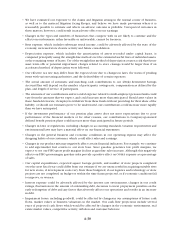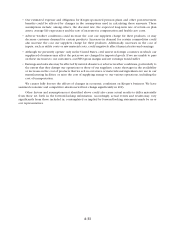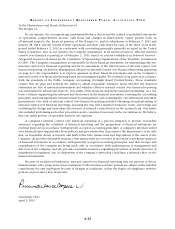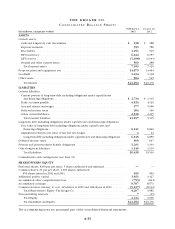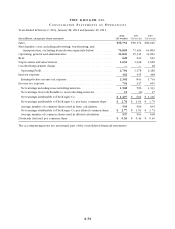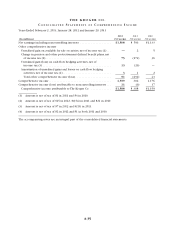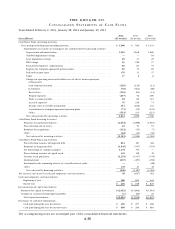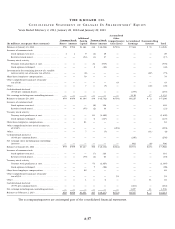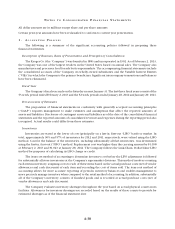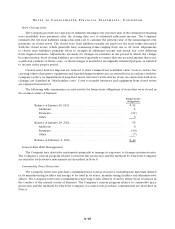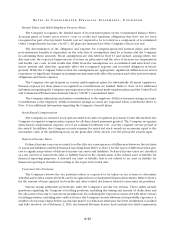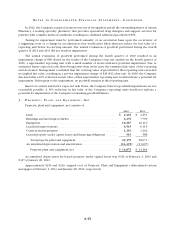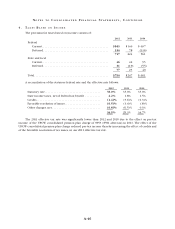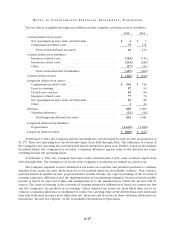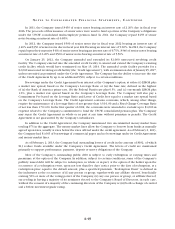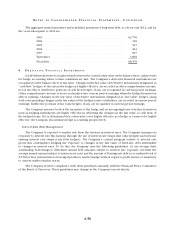Kroger 2012 Annual Report Download - page 98
Download and view the complete annual report
Please find page 98 of the 2012 Kroger annual report below. You can navigate through the pages in the report by either clicking on the pages listed below, or by using the keyword search tool below to find specific information within the annual report.
A-40
NO T E S T O C O N S O L I D A T E D F I N A N C I A L S T A T E M E N T S , CO N T I N U E D
Store Closing Costs
The Company provides for closed store liabilities relating to the present value of the estimated remaining
non-cancellable lease payments after the closing date, net of estimated subtenant income. The Company
estimates the net lease liabilities using a discount rate to calculate the present value of the remaining net rent
payments on closed stores. The closed store lease liabilities usually are paid over the lease terms associated
with the closed stores, which generally have remaining terms ranging from one to 20 years. Adjustments
to closed store liabilities primarily relate to changes in subtenant income and actual exit costs differing
from original estimates. Adjustments are made for changes in estimates in the period in which the change
becomes known. Store closing liabilities are reviewed quarterly to ensure that any accrued amount that is not
a sufficient estimate of future costs, or that no longer is needed for its originally intended purpose, is adjusted
to income in the proper period.
Owned stores held for disposal are reduced to their estimated net realizable value. Costs to reduce the
carrying values of property, equipment and leasehold improvements are accounted for in accordance with the
Company’s policy on impairment of long-lived assets. Inventory write-downs, if any, in connection with store
closings, are classified in “Merchandise costs.” Costs to transfer inventory and equipment from closed stores
are expensed as incurred.
The following table summarizes accrual activity for future lease obligations of stores that were closed in
the normal course of business:
Future Lease
Obligations
Balance at January 29, 2011 .................................. $ 52
Additions .............................................. 9
Payments .............................................. (11)
Other ................................................. 5
Balance at January 28, 2012 .................................. 55
Additions .............................................. 6
Payments .............................................. (10)
Other ................................................. (7)
Balance at February 2, 2013 .................................. $ 44
Interest Rate Risk Management
The Company uses derivative instruments primarily to manage its exposure to changes in interest rates.
The Company’s current program relative to interest rate protection and the methods by which the Company
accounts for its derivative instruments are described in Note 6.
Commodity Price Protection
The Company enters into purchase commitments for various resources, including raw materials utilized
in its manufacturing facilities and energy to be used in its stores, manufacturing facilities and administrative
offices. The Company enters into commitments expecting to take delivery of and to utilize those resources in
the conduct of the normal course of business. The Company’s current program relative to commodity price
protection and the methods by which the Company accounts for its purchase commitments are described in
Note 6.


